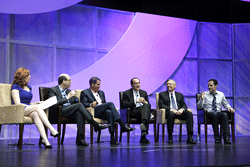Consumers are watching movies on their smartphones and checking voice mail on their television sets, all the while chatting with friends on their computers. Can any of this be called "television" anymore? During The Cable Show's closing general session yesterday, industry heavyweights answered this question from a variety of perspectives.
(L-R) Moderator Liz Claman, Matt Blank, Ari Emanuel, Tom Rogers, Tom Rutledge, Ev Willams.
"We're still defining this as television. I think we need to redo a couple of definitions. We have to redefine what we do as content," said super-agent Ari Emanuel, CEO of William Morris Endeavor Entertainment. The bright lines among the various communications platforms are definitely becoming blurred, all the panelists agreed.
"Think about what an iPad is," said Tom Rutledge, COO of Cablevision Systems. "Sometimes it's a television; sometimes it's a set-top box; sometimes it's a remote control; sometimes it's a computer; sometimes its a TiVo." Social networking, perhaps more than anything else, is turning around the old model of one-to-many programming transmission, but at the same time can help drive viewers to traditional TV viewing.
Twitter users spend a lot of time talking about the TV shows they watch, Twitter's Founder & CEO Evan Williams said, with tweets fueling TV programming discovery and consumption. Twitter, he noted, "really thrives with aliveness. It can really bring back this idea of shared events. Half of the interest is that everyone is enjoying it together." In some respects, social networking is just reflective of old media consumption.
"There's nothing new about the social aspects of media. People gathered around radio listening to an episode of The Shadow," Showtime Networks CEO Matt Blank said.
But don't think that what applied to one medium can easily transfer to the new media, Tom Rogers, CEO and President of TiVo warned. "It's much more complicated than getting what's on the PC to the TV. You have to have a TV-centric way to do this." After all, the vast majority of TV viewing is still done in traditional fashion and the industry must keep the TV set in mind.
"You can build a machine to move anything from one part of the infrastructure to another part of the infrastructure," Rutledge said. "If you have a television program on the Internet, it can be on the big screen TV. You have to think about how you're in business."
